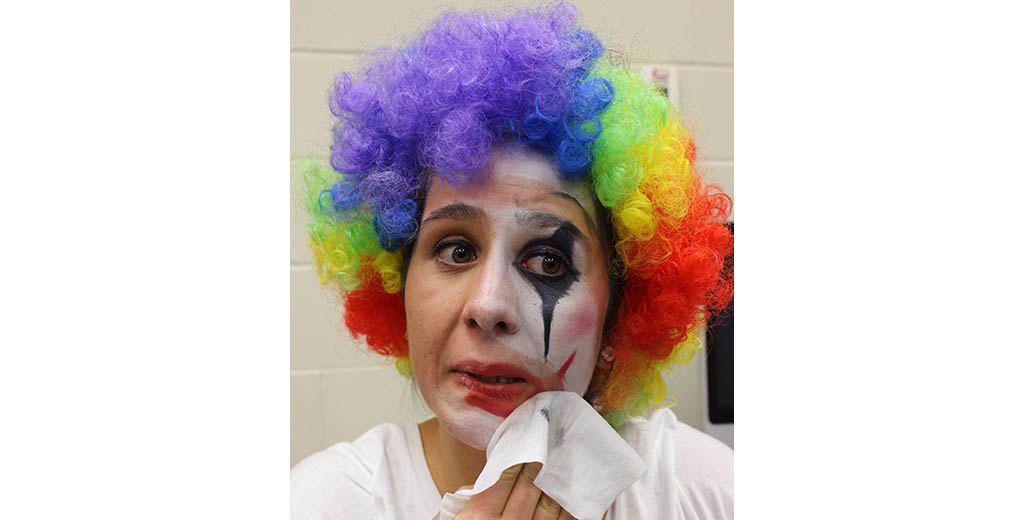Unmasking the clown: A brief history of clowning and fear
 CREDIT: JESSICA THOMPSON
CREDIT: JESSICA THOMPSONAt what point did the face beneath the paint instil fear rather than joy; at what point did clowns become an object of nightmares rather than someone you bring to a birthday party?
The recent killer clown phenomenon made its way to London as local high schools were threatened with the kidnapping of students and killing of teachers. While no clowns were spotted during the school day, students were surely on the lookout for anyone with a big red nose and oversized shoes. Charges were laid against two middle school students over the incident.
It sounds bizarre that something as silly-looking as a clown can strike terror into the hearts of so many people. When did clowns turn from friendly entertainers into homicidal maniacs? How did television’s Bozo the Clown and Ronald McDonald give way to Stephen King’s Pennywise and Batman’s The Joker? Like them or not (and many seem to not), clowns have been culturally relevant for many years and will continue to stay relevant.
Although clowns have often been seen as figures of terror and mayhem in recent popular culture, the idea of the clown is something that extends back to early human civilization. Informative website and clown forum allaboutclowns.com said that Ancient Greeks, Egyptians and medieval Europeans all had some form of jester figure, a mischievous individual who entertained the ruling class while also offering a healthy dose of criticism.
These clowns were a way for the voices of the people to be expressed in a unique way. The exaggerated features and ill-fitting costumes that clowns are still associated with today came later on from British clowning legend Joseph Grimaldi. Pantomime preservation website its-behind-you.com said that in the late 1700’s, Grimaldi took a more comedic approach to clowning, adding physical comedy and garish costumes to the clown role. In a sense, Grimaldi was still expressing the voices of the people: at the height of his popularity about one eighth of all London, England’s population had seen him perform onstage. His style of clowning was one that combined pantomime, theatre and comedy in an attempt to entertain people.
However, the brightly dressed jokester onstage was quite different from his persona with the makeup removed. Comedy came at a price, usually involving physical pain directed at Grimaldi. In his later years he died a lonely alcoholic, estranged from his son and ex-wife. The divide between Grimaldi’s Joey the Clown and his off-stage personality was striking.
Following his career were some key pop culture figures that shaped the identity of the generic clown. Characters like Howdy Doody’s Clarabelle the Clown and Ronald McDonald reinforced the idea that clowns were simply there to entertain by engaging and sometimes teaching children.
But when Stephen King’s novel and film It was released in the late ‘80s, things started to sour for the clown’s public image. The dark, mischievous side of clowns had been revealed once more, and people latched onto the idea of the killer clown. Whether it was the generic face-paint that could have masked absolutely anybody or the distinction between the happy-go-lucky look of the clown and the actions they committed, clowns were vilified by society.
Fictional figures like The Joker kept the image of the maniacal clown fresh in society’s mind by providing them with a constant supply of reinforcement that clowns were more bad than good. To top it all off, it was revealed that serial killer John Wayne Gacy Jr. often performed as his clowning persona Pogo the Clown. Not only were killer clowns being featured in media, they were bleeding into real life.
While clowns have received a lot of bad press in the media, not all clowns are killing machines. Clowning is still an active profession that is filled with good-hearted people who love to bring joy to people and light up their face with a balloon animal or a funny joke. London is host to a whole slew of professional clowns who offer their services for birthday parties and other events.
Shelley Summers, a performer from Dotsy’s Entertainment Company and Costume Shop, a company that offers services in Southwestern Ontario including London and St.Thomas, said the business has not been affected by the clown phenomenon, however that doesn’t mean it hasn’t affected her personally.
“For the first time in 23 years, I feel uncomfortable being in costume and makeup prior to and after each event,” Summers said. Summers said that she believes all the coverage the clowns have been getting is increasing the length of the situation and is getting far too much attention.
“These people [scaring others] aren’t clowns. These are teenagers being jerks. If the trend was to dress up like a scary doctor, would it be reflected on all doctors? No,” Summers said.
“The art of clowning is to bring joy. Period.”
In the midst of a social phenomenon based around clowns it’s important to realize that this recent phenomenon of homicidal clowns attempting to lure children into the forest or threatening schools isn’t representative of the modern clowning community. While the idea of the evil clown is still fresh in many people’s mind (phobia of clowns is quite common in western society), people need to move past their collective grudge against clowns and try to see them with an open mind and an open heart.
In the case of London’s clown threat, it seems that the students, and the others engaging in the recent creepy clown movement, weren’t really using clowns specifically because they scare people, but because they are a kind of anonymous identity to hide behind. Anyone can put on face paint and wear a crazy outfit, but that doesn’t necessarily make them a real clown. Unfortunately, the clown often goes unmasked, leaving the mystery and suspense all up to society’s judgement.














